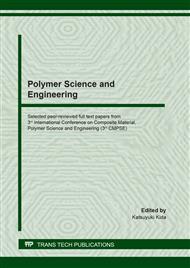[1]
J. C. Kelly, J. L. Sullivan, A. Burnham, and A. Elgowainy, Impacts of Vehicle Weight Reduction via Material Substitution on Life-Cycle Greenhouse Gas Emissions,, Environ. Sci. Technol., vol. 49, no. 20, p.12535–12542, (2015).
DOI: 10.1021/acs.est.5b03192
Google Scholar
[2]
H. C. Kim and T. J. Wallington, Life cycle assessment of vehicle lightweighting: A physics-based model of mass-induced fuel consumption,, Environ. Sci. Technol., vol. 47, no. 24, p.14358–14366, (2013).
DOI: 10.1021/es402954w
Google Scholar
[3]
A. Ali et al., Hydrophobic treatment of natural fibers and their composites—A review,, J. Ind. Text., vol. 47, no. 8, p.2153–2183, (2018).
Google Scholar
[4]
D. B. Dittenber and H. V. S. Gangarao, Critical review of recent publications on use of natural composites in infrastructure,, Compos. Part A Appl. Sci. Manuf., vol. 43, no. 8, p.1419–1429, (2012).
DOI: 10.1016/j.compositesa.2011.11.019
Google Scholar
[5]
K. Liu, H. Takagi, R. Osugi, and Z. Yang, Effect of lumen size on the effective transverse thermal conductivity of unidirectional natural fiber composites,, Compos. Sci. Technol., vol. 72, no. 5, p.633–639, (2012).
DOI: 10.1016/j.compscitech.2012.01.009
Google Scholar
[6]
O. Faruk, A. K. Bledzki, H. P. Fink, and M. Sain, Biocomposites reinforced with natural fibers: 2000-2010,, Prog. Polym. Sci., vol. 37, no. 11, p.1552–1596, (2012).
DOI: 10.1016/j.progpolymsci.2012.04.003
Google Scholar
[7]
P. Takkalkar, S. Nizamuddin, G. Griffin, and N. Kao, Thermal properties of sustainable thermoplastics nanocomposites containing nanofillers and its recycling perspective,, in Sustainable Polymer Composites and Nanocomposites, A. A. Inamuddin, Thomas S., Kumar Mishra R., Ed. Springer, Cham, 2019, p.915–933.
DOI: 10.1007/978-3-030-05399-4_31
Google Scholar
[8]
U. K. Vaidya and K. K. Chawla, Processing of fibre reinforced thermoplastic composites,, Int. Mater. Rev., vol. 53, no. 4, p.185–218, (2008).
Google Scholar
[9]
A. Hassan, M. R. Mohd Isa, and Z. A. Mohd. Ishak, Improving Thermal and Mechanical Properties of Injection Moulded Kenaf Fibre-reinforced Polyhydroxy- butyrate Composites through Fibre Surface Treatment,, BioResources, vol. 14, no. 2, p.3101–3116, (2019).
DOI: 10.1002/pc.24605
Google Scholar
[10]
M. B. Alanalp, A. Durmus, and I. Aydin, Quantifying effect of inorganic filler geometry on the structural, rheological and viscoelastic properties of polypropylene-based thermoplastic elastomers,, J. Polym. Res., vol. 26, no. 2, (2019).
DOI: 10.1007/s10965-019-1711-y
Google Scholar
[11]
V. G. Grinev et al., The Effect of Filler Type on the Mechanical Properties of Composite Materials Based on Ultra-High-Molecular-Weight Polyethylene,, Polym. Sci. Ser. D, vol. 11, no. 2, p.202–208, (2018).
DOI: 10.1134/s1995421218020089
Google Scholar
[12]
R. Gogoi, N. Kumar, S. Mireja, S. S. Ravindranath, G. Manik, and S. Sinha, Effect of Hollow Glass Microspheres on the Morphology, Rheology and Crystallinity of Short Bamboo Fiber-Reinforced Hybrid Polypropylene Composite,, J. Miner. Met. Mater. Soc., vol. 71, no. 2, p.548–558, (2019).
DOI: 10.1007/s11837-018-3268-3
Google Scholar
[13]
N. Kumar, S. Mireja, V. Khandelwal, B. Arun, and G. Manik, Light-weight high-strength hollow glass microspheres and bamboo fiber based hybrid polypropylene composite: A strength analysis and morphological study,, Compos. Part B Eng., vol. 109, p.277–285, (2017).
DOI: 10.1016/j.compositesb.2016.10.052
Google Scholar
[14]
R. Gogoi, G. Manik, and B. Arun, High specific strength hybrid polypropylene composites using carbon fibre and hollow glass microspheres: Development, characterization and comparison with empirical models,, Compos. Part B Eng., (2019).
DOI: 10.1016/j.compositesb.2019.05.086
Google Scholar
[15]
V. Arikan and O. Sayman, Comparative study on repeated impact response of E-glass fiber reinforced polypropylene & epoxy matrix composites,, Compos. Part B Eng., vol. 83, p.1–6, (2015).
DOI: 10.1016/j.compositesb.2015.08.051
Google Scholar


